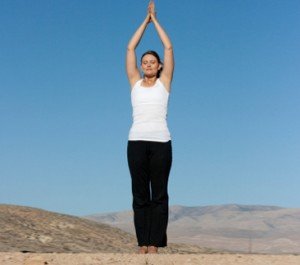 Tadasana, also called Samasthiti. Tada means a mountain. Sama means upright, straight, unmoved. Sthiti is standing still, steadiness. Tadasana, therefore implies a pose where one stands firm and erect as a mountain. This is the basic standing pose.
Tadasana, also called Samasthiti. Tada means a mountain. Sama means upright, straight, unmoved. Sthiti is standing still, steadiness. Tadasana, therefore implies a pose where one stands firm and erect as a mountain. This is the basic standing pose.
Techniques:
- Stand erect with feet together, the heels and big toes touching each other. Rest the head of metatarsals on the floor and stretch all the toes flat on the floor.
- Tighten the knees and pull the knee-caps, contract the hips and pull up the muscles at the back of the thighs.
- Keep the stomach in, chest forward, spine stretched up and the neck straight.
- Do not bear the weight of the body either on the heels or the toes, but distribute it evenly on them both.
- Ideally in Tadasana the arms are stretched out over the head, but for the sake of convenience, one can place them by the side of thighs.
Effects:
People do not pay attention to the correct method of standing. Some stand with the body weight thrown only on one leg, or with one leg turned completely sideways. Others bear all the weight on the heels, or on the inner and outer edges of the feet.
Owing to our faulty method of standing and not distributing the body weight evenly on the feet, we acquire specific deformities which hamper spine elasticity. Even if the feet are kept apart, it is better to keep the heel and toe in a line parallel to the median plane and not at an angle.
By this method, the hips are contracted, the abdomen is pulled in and the chest is brought forward. One feels light in body and the mind acquires agility.
If we stand with the body weight thrown only on heels, we feel the centre of gravity changing; the hips become loose, the abdomen protrudes, the body hangs back and the spine feels the strain and consequently we soon feel fatigued and the mind becomes dull. It is therefore essential to master the art of standing correctly.
 Optical Network
Optical Network






